Jiaqi Zeng
Nemotron-H: A Family of Accurate and Efficient Hybrid Mamba-Transformer Models
Apr 10, 2025Abstract:As inference-time scaling becomes critical for enhanced reasoning capabilities, it is increasingly becoming important to build models that are efficient to infer. We introduce Nemotron-H, a family of 8B and 56B/47B hybrid Mamba-Transformer models designed to reduce inference cost for a given accuracy level. To achieve this goal, we replace the majority of self-attention layers in the common Transformer model architecture with Mamba layers that perform constant computation and require constant memory per generated token. We show that Nemotron-H models offer either better or on-par accuracy compared to other similarly-sized state-of-the-art open-sourced Transformer models (e.g., Qwen-2.5-7B/72B and Llama-3.1-8B/70B), while being up to 3$\times$ faster at inference. To further increase inference speed and reduce the memory required at inference time, we created Nemotron-H-47B-Base from the 56B model using a new compression via pruning and distillation technique called MiniPuzzle. Nemotron-H-47B-Base achieves similar accuracy to the 56B model, but is 20% faster to infer. In addition, we introduce an FP8-based training recipe and show that it can achieve on par results with BF16-based training. This recipe is used to train the 56B model. All Nemotron-H models will be released, with support in Hugging Face, NeMo, and Megatron-LM.
Dedicated Feedback and Edit Models Empower Inference-Time Scaling for Open-Ended General-Domain Tasks
Mar 06, 2025Abstract:Inference-Time Scaling has been critical to the success of recent models such as OpenAI o1 and DeepSeek R1. However, many techniques used to train models for inference-time scaling require tasks to have answers that can be verified, limiting their application to domains such as math, coding and logical reasoning. We take inspiration from how humans make first attempts, ask for detailed feedback from others and make improvements based on such feedback across a wide spectrum of open-ended endeavors. To this end, we collect data for and train dedicated Feedback and Edit Models that are capable of performing inference-time scaling for open-ended general-domain tasks. In our setup, one model generates an initial response, which are given feedback by a second model, that are then used by a third model to edit the response. We show that performance on Arena Hard, a benchmark strongly predictive of Chatbot Arena Elo can be boosted by scaling the number of initial response drafts, effective feedback and edited responses. When scaled optimally, our setup based on 70B models from the Llama 3 family can reach SoTA performance on Arena Hard at 92.7 as of 5 Mar 2025, surpassing OpenAI o1-preview-2024-09-12 with 90.4 and DeepSeek R1 with 92.3.
HelpSteer2-Preference: Complementing Ratings with Preferences
Oct 02, 2024Abstract:Reward models are critical for aligning models to follow instructions, and are typically trained following one of two popular paradigms: Bradley-Terry style or Regression style. However, there is a lack of evidence that either approach is better than the other, when adequately matched for data. This is primarily because these approaches require data collected in different (but incompatible) formats, meaning that adequately matched data is not available in existing public datasets. To tackle this problem, we release preference annotations (designed for Bradley-Terry training) to complement existing ratings (designed for Regression style training) in the HelpSteer2 dataset. To improve data interpretability, preference annotations are accompanied with human-written justifications. Using this data, we conduct the first head-to-head comparison of Bradley-Terry and Regression models when adequately matched for data. Based on insights derived from such a comparison, we propose a novel approach to combine Bradley-Terry and Regression reward modeling. A Llama-3.1-70B-Instruct model tuned with this approach scores 94.1 on RewardBench, emerging top of more than 140 reward models as of 1 Oct 2024. We also demonstrate the effectiveness of this reward model at aligning models to follow instructions in RLHF. We open-source this dataset (CC-BY-4.0 license) at https://huggingface.co/datasets/nvidia/HelpSteer2 and openly release the trained Reward Model at https://huggingface.co/nvidia/Llama-3.1-Nemotron-70B-Reward
GPT vs RETRO: Exploring the Intersection of Retrieval and Parameter-Efficient Fine-Tuning
Jul 05, 2024Abstract:Parameter-Efficient Fine-Tuning (PEFT) and Retrieval-Augmented Generation (RAG) have become popular methods for adapting large language models while minimizing compute requirements. In this paper, we apply PEFT methods (P-tuning, Adapters, and LoRA) to a modified Retrieval-Enhanced Transformer (RETRO) and a baseline GPT model across several sizes, ranging from 823 million to 48 billion parameters. We show that RETRO models outperform GPT models in zero-shot settings due to their unique pre-training process but GPT models have higher performance potential with PEFT. Additionally, our study indicates that 8B parameter models strike an optimal balance between cost and performance and P-tuning lags behind other PEFT techniques. We further provide a comparative analysis of between applying PEFT to an Instruction-tuned RETRO model and base RETRO model. This work presents the first comprehensive comparison of various PEFT methods integrated with RAG, applied to both GPT and RETRO models, highlighting their relative performance.
Nemotron-4 340B Technical Report
Jun 17, 2024



Abstract:We release the Nemotron-4 340B model family, including Nemotron-4-340B-Base, Nemotron-4-340B-Instruct, and Nemotron-4-340B-Reward. Our models are open access under the NVIDIA Open Model License Agreement, a permissive model license that allows distribution, modification, and use of the models and its outputs. These models perform competitively to open access models on a wide range of evaluation benchmarks, and were sized to fit on a single DGX H100 with 8 GPUs when deployed in FP8 precision. We believe that the community can benefit from these models in various research studies and commercial applications, especially for generating synthetic data to train smaller language models. Notably, over 98% of data used in our model alignment process is synthetically generated, showcasing the effectiveness of these models in generating synthetic data. To further support open research and facilitate model development, we are also open-sourcing the synthetic data generation pipeline used in our model alignment process.
HelpSteer2: Open-source dataset for training top-performing reward models
Jun 12, 2024Abstract:High-quality preference datasets are essential for training reward models that can effectively guide large language models (LLMs) in generating high-quality responses aligned with human preferences. As LLMs become stronger and better aligned, permissively licensed preference datasets, such as Open Assistant, HH-RLHF, and HelpSteer need to be updated to remain effective for reward modeling. Methods that distil preference data from proprietary LLMs such as GPT-4 have restrictions on commercial usage imposed by model providers. To improve upon both generated responses and attribute labeling quality, we release HelpSteer2, a permissively licensed preference dataset (CC-BY-4.0). Using a powerful internal base model trained on HelpSteer2, we are able to achieve the SOTA score (92.0%) on Reward-Bench's primary dataset, outperforming currently listed open and proprietary models, as of June 12th, 2024. Notably, HelpSteer2 consists of only ten thousand response pairs, an order of magnitude fewer than existing preference datasets (e.g., HH-RLHF), which makes it highly efficient for training reward models. Our extensive experiments demonstrate that reward models trained with HelpSteer2 are effective in aligning LLMs. In particular, we propose SteerLM 2.0, a model alignment approach that can effectively make use of the rich multi-attribute score predicted by our reward models. HelpSteer2 is available at https://huggingface.co/datasets/nvidia/HelpSteer2 and code is available at https://github.com/NVIDIA/NeMo-Aligner
NeMo-Aligner: Scalable Toolkit for Efficient Model Alignment
May 02, 2024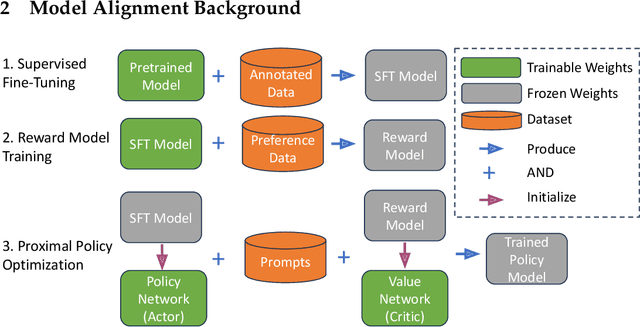
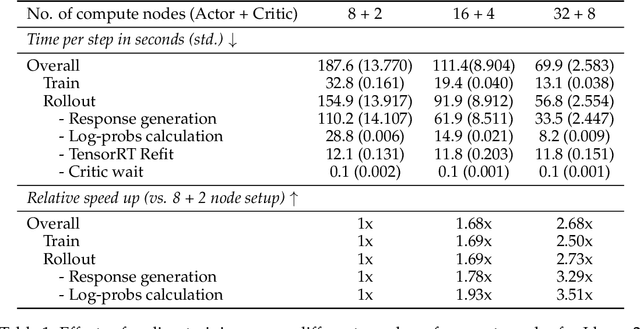

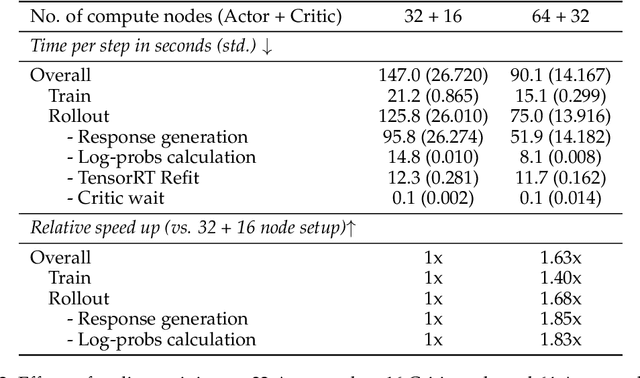
Abstract:Aligning Large Language Models (LLMs) with human values and preferences is essential for making them helpful and safe. However, building efficient tools to perform alignment can be challenging, especially for the largest and most competent LLMs which often contain tens or hundreds of billions of parameters. We create NeMo-Aligner, a toolkit for model alignment that can efficiently scale to using hundreds of GPUs for training. NeMo-Aligner comes with highly optimized and scalable implementations for major paradigms of model alignment such as: Reinforcement Learning from Human Feedback (RLHF), Direct Preference Optimization (DPO), SteerLM, and Self-Play Fine-Tuning (SPIN). Additionally, our toolkit supports running most of the alignment techniques in a Parameter Efficient Fine-Tuning (PEFT) setting. NeMo-Aligner is designed for extensibility, allowing support for other alignment techniques with minimal effort. It is open-sourced with Apache 2.0 License and we invite community contributions at https://github.com/NVIDIA/NeMo-Aligner
HelpSteer: Multi-attribute Helpfulness Dataset for SteerLM
Nov 16, 2023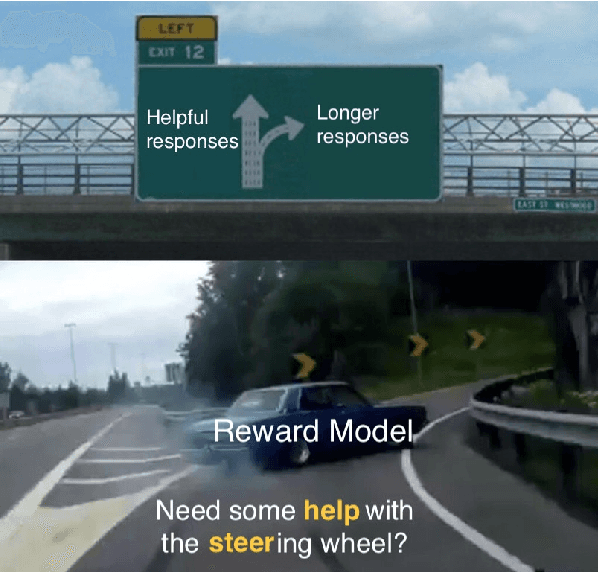

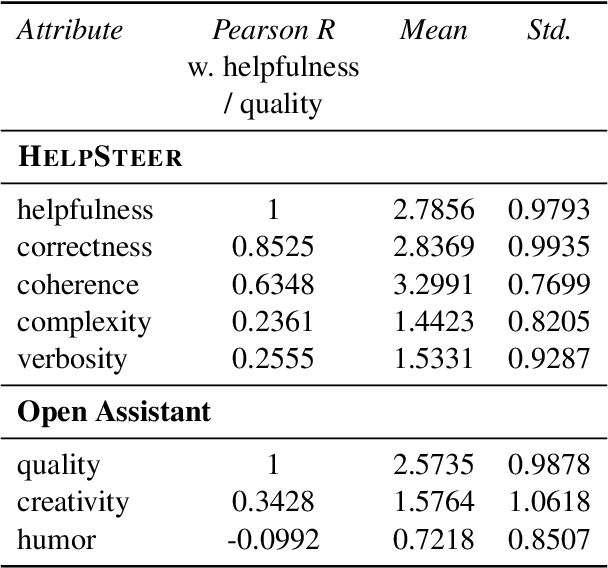
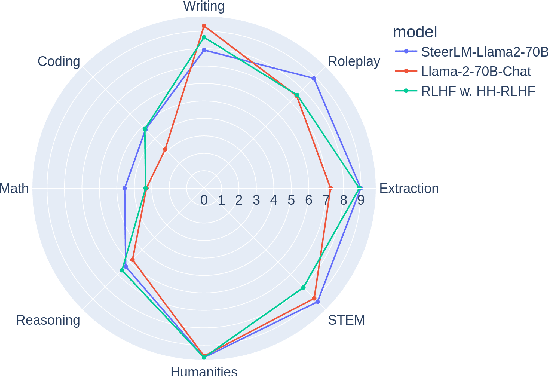
Abstract:Existing open-source helpfulness preference datasets do not specify what makes some responses more helpful and others less so. Models trained on these datasets can incidentally learn to model dataset artifacts (e.g. preferring longer but unhelpful responses only due to their length). To alleviate this problem, we collect HelpSteer, a multi-attribute helpfulness dataset annotated for the various aspects that make responses helpful. Specifically, our 37k-sample dataset has annotations for correctness, coherence, complexity, and verbosity in addition to overall helpfulness of responses. Training Llama 2 70B using the HelpSteer dataset with SteerLM technique produces a model that scores 7.54 on MT Bench, which is currently the highest score for open models that do not require training data from more powerful models (e.g. GPT4). We release this dataset with CC-BY-4.0 license at https://huggingface.co/datasets/nvidia/HelpSteer
Uncovering Main Causalities for Long-tailed Information Extraction
Sep 11, 2021



Abstract:Information Extraction (IE) aims to extract structural information from unstructured texts. In practice, long-tailed distributions caused by the selection bias of a dataset, may lead to incorrect correlations, also known as spurious correlations, between entities and labels in the conventional likelihood models. This motivates us to propose counterfactual IE (CFIE), a novel framework that aims to uncover the main causalities behind data in the view of causal inference. Specifically, 1) we first introduce a unified structural causal model (SCM) for various IE tasks, describing the relationships among variables; 2) with our SCM, we then generate counterfactuals based on an explicit language structure to better calculate the direct causal effect during the inference stage; 3) we further propose a novel debiasing approach to yield more robust predictions. Experiments on three IE tasks across five public datasets show the effectiveness of our CFIE model in mitigating the spurious correlation issues.
Contrastive Self-supervised Learning for Graph Classification
Sep 13, 2020



Abstract:Graph classification is a widely studied problem and has broad applications. In many real-world problems, the number of labeled graphs available for training classification models is limited, which renders these models prone to overfitting. To address this problem, we propose two approaches based on contrastive self-supervised learning (CSSL) to alleviate overfitting. In the first approach, we use CSSL to pretrain graph encoders on widely-available unlabeled graphs without relying on human-provided labels, then finetune the pretrained encoders on labeled graphs. In the second approach, we develop a regularizer based on CSSL, and solve the supervised classification task and the unsupervised CSSL task simultaneously. To perform CSSL on graphs, given a collection of original graphs, we perform data augmentation to create augmented graphs out of the original graphs. An augmented graph is created by consecutively applying a sequence of graph alteration operations. A contrastive loss is defined to learn graph encoders by judging whether two augmented graphs are from the same original graph. Experiments on various graph classification datasets demonstrate the effectiveness of our proposed methods.
 Add to Chrome
Add to Chrome Add to Firefox
Add to Firefox Add to Edge
Add to Edge